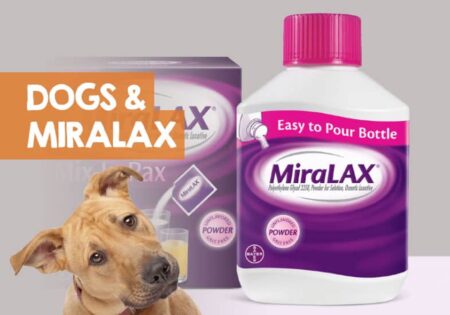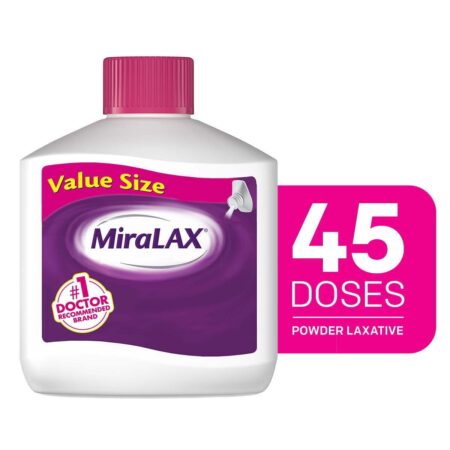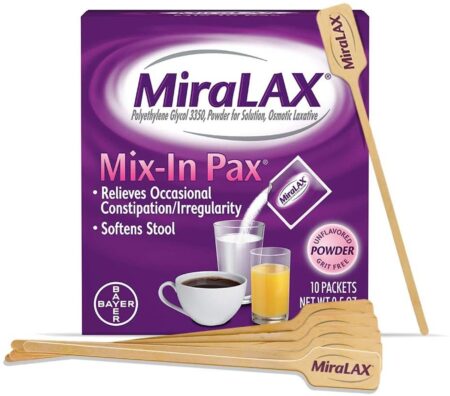
Can You Give A Dog Miralax?
Miralax, also known as Polyethylene glycol, is a commonly used laxative in humans. Many pet owners wonder if it is safe to give their dogs Miralax as a solution for constipation. This topic has sparked debates and concerns among pet owners and veterinarians alike.
In this article, we will explore the potential benefits, risks, and guidelines for giving a dog Miralax. We will also discuss alternative methods for treating constipation in dogs and the importance of consulting a veterinarian before administering any medication to your furry friend.
Can You Give A Dog Miralax?
Yes, Miralax can be given to dogs to help with constipation or other intestinal issues. However, it is important to always consult with a veterinarian before giving any medication to a dog, as the dosage and frequency may differ from that of humans. Additionally, it is important to follow the vet’s instructions and monitor the dog’s response to the medication.
What Is Miralax?
Miralax is a brand name for the medication polyethylene glycol 3350. It is a laxative used to relieve constipation. It works by drawing water into the colon, making the stool softer and easier to pass. Miralax is available over-the-counter and is also used to prepare for certain medical procedures or surgeries that require the bowels to be empty. It is also commonly used as a long-term treatment for chronic constipation.
Can You Give A Dog Miralax Powder?
Yes, it is generally considered safe to give dogs Miralax powder, a laxative medication, when prescribed by a veterinarian. Miralax powder contains the active ingredient polyethylene glycol 3350, which works by pulling water into the intestines to help soften stool and make it easier to pass. Miralax is not addictive or habit-forming, and it is not known to cause any serious side effects in dogs. However, it is important to consult with a veterinarian before giving Miralax to your dog, as there may be other treatments that are more appropriate for your pet’s specific condition.
Miralax Dosage for Dogs by Weight
The dosage of Miralax for dogs will vary depending on the size and weight of the dog. Generally, the recommended dosage is 1/4 teaspoon per 10 pounds of body weight, given once or twice daily. For example, a 30-pound dog would be given 3/4 teaspoon of Miralax once or twice per day. It is important to follow the instructions given by your veterinarian, as the dosage may vary depending on the specific condition being treated. You should also consult with your veterinarian before starting any new medication for your dog. In addition, you should always make sure that your dog has access to plenty of fresh water.
How Much Miralax for A 50 LB Dog?
For a 50-pound dog, the recommended dosage of Miralax is typically 1 1/4 teaspoons per day, given once or twice daily. Again, it is important to follow the specific instructions given by your veterinarian. In general, you should give your dog Miralax with water or food, and make sure that your dog drinks plenty of water throughout the day. You should also monitor your dog for any adverse effects, such as diarrhea or vomiting, and contact your veterinarian if you have any concerns. It is also important to keep in mind that Miralax is not a cure for constipation, and it should only be used when necessary.
How Much Miralax for 10 LB Dog?
For a 10-pound dog, the recommended dosage of Miralax is typically 1/4 teaspoon per day, given once or twice daily. However, you should always consult with your veterinarian before administering Miralax to your dog. Your veterinarian will be able to provide you with the most accurate dosage information based on your dog’s individual needs. You should also monitor your dog closely while he or she is taking Miralax, and contact your veterinarian immediately if you notice any adverse effects. Remember, Miralax is not a substitute for proper diet and exercise, so be sure to feed your dog a healthy, balanced diet and provide plenty of fresh water.
SEE ALSO: Can I Walk My Dog 30 Minutes After Eating?
How Much Miralax for 20 LB Dog?
For a 20-pound dog, the recommended dosage of Miralax is typically 1/2 to 3/4 teaspoon per day, given once or twice daily. Keep in mind that this is only a general recommendation, and the dosage may vary based on your dog’s specific health condition and other factors. Therefore, it is always best to follow the specific dosage instructions provided by your veterinarian. If you have any questions or concerns about the dosage, be sure to discuss them with your veterinarian. Also, keep an eye on your dog while he or she is taking Miralax, and be sure to report any adverse effects to your vet.
What Are The Benefits Of Giving Miralax To A Dog?
- Relieves Constipation: One of the main benefits of giving Miralax to a dog is that it helps to relieve constipation. This is especially important for older dogs or those with certain health conditions that may make them prone to constipation. Miralax works by drawing water into the colon, making the stool softer and easier to pass.
- Non-Toxic and Safe for Long-Term Use: Miralax is a non-toxic and safe medication for dogs, making it suitable for long-term use if needed. Unlike some laxatives that can be harsh and cause uncomfortable side effects, Miralax is gentle and does not interfere with the natural digestive processes of the dog.
- Easy to Administer: Miralax comes in a powder form that can be easily mixed with a dog’s food or water. This makes it easier to administer to dogs who are picky eaters or have difficulty taking medications in pill form. It also means there is no need for stressful and time-consuming force-feeding.
- Treats Other Digestive Issues: In addition to relieving constipation, Miralax can also be used to treat other digestive issues in dogs such as diarrhea or fecal incontinence. This is because it helps to regulate bowel movements and keep the stool at a consistency that is easier for the dog to pass.
- Used for Various Health Conditions: Miralax is a versatile medication that can be used to treat a variety of health conditions in dogs. It is commonly used for constipation, but it can also be given to dogs with certain medical conditions such as kidney disease or obesity to manage digestive symptoms and maintain regularity.
- Suitable for Dogs of All Ages: Unlike some laxatives that are not suitable for use in puppies or senior dogs, Miralax is safe for use in dogs of all ages. This makes it a good option for owners who have multiple dogs of different ages and want to have a single medication for their entire pack.
- No Prescription Required: Miralax is an over-the-counter medication that does not require a prescription from a veterinarian. This makes it easily accessible for dog owners and can save them a trip to the vet’s office for a minor issue.
- Affordable: Compared to other prescribed medications for digestive issues, Miralax is relatively affordable. This makes it a cost-effective option for dog owners who may have to give their dogs long-term treatment.
- Minimal Side Effects: Miralax is generally well-tolerated by dogs with minimal side effects. In rare cases, it may cause mild stomach upset or bloating, but these effects are usually temporary and resolve on their own.
- Prevents Complications: When a dog is constipated, there is a risk of complications such as fecal impaction or megacolon, which can be serious and even life-threatening for the dog. By relieving constipation, Miralax can help prevent these complications and keep the dog healthy and comfortable.
Miralax for Dogs Side Effects
Miralax, also known as polyethylene glycol 3350, is a commonly used laxative for dogs. It works by drawing water into the stool, making it easier for the dog to pass bowel movements. While it is generally safe and effective, there are potential side effects that pet owners should be aware of.
- Dehydration: The most common side effect of Miralax use in dogs is dehydration. This is because it draws water from the body into the stool, which can lead to increased thirst and urination. It is important to make sure your dog has access to plenty of fresh water while taking Miralax and to monitor their hydration levels closely.
- Electrolyte imbalances: Miralax can also cause imbalances in the body’s electrolytes, such as sodium, potassium, and magnesium. This can lead to symptoms such as weakness, lethargy, and muscle twitches. It is important to consult with your veterinarian if you notice any of these signs while your dog is taking Miralax.
- Digestive upset: Some dogs may experience digestive upset while taking Miralax, including diarrhea, nausea, and vomiting. This is more likely to occur if the dog is sensitive to the medication or if the dosage is too high. If your dog experiences digestive upset, consult with your veterinarian about adjusting the dosage or trying a different treatment.
- Allergic reactions: In rare cases, dogs may have an allergic reaction to Miralax. Signs of an allergic reaction can include swelling of the face or tongue, hives, difficulty breathing, and collapse. If you suspect your dog is having an allergic reaction, seek immediate veterinary care.
- Interactions with other medications: Miralax may interact with other medications that your dog is taking, particularly those that slow down gastrointestinal motility. This can lead to an increased risk of side effects or decreased effectiveness of the medication. Make sure to inform your veterinarian of any other medications your dog is on before starting Miralax.
In general, the side effects of Miralax are mild and uncommon. However, it is important to monitor your dog’s response to the medication and report any concerning symptoms to your veterinarian. Your vet may recommend adjusting the dosage or trying a different treatment if your dog experiences side effects from Miralax.
How Long Does It Take for Miralax to Work in Dogs?
Miralax typically starts working within 24 to 48 hours in dogs, although the time may vary depending on the individual dog’s metabolism and other factors. In some cases, it may take up to three days for Miralax to produce noticeable results. It is also important to note that Miralax does not work immediately, so you may not see results right away. If your dog’s condition does not improve within a few days, or if it gets worse, be sure to contact your veterinarian.
How Do You Give Miralax To A Dog?
Consult with your veterinarian: Before giving Miralax to your dog, it is important to consult with your veterinarian to determine the appropriate dosage for your dog based on their weight and condition.
- Mix it with food: The easiest way to give Miralax to your dog is by mixing it with their food. Measure out the recommended dosage of Miralax and mix it into a small amount of wet food or low-sodium broth. Make sure your dog finishes all the food to ensure they ingest the full dose of Miralax.
- Use a syringe: If your dog is a picky eater or refuses to eat the food with Miralax mixed in, you can use a syringe to administer the medication directly into their mouth. Draw up the recommended dose of Miralax into the syringe and gently squirt it into the back of their mouth. Be careful not to squirt the medication too quickly to avoid choking.
- Dilute in water: Another option is to mix the Miralax into a small amount of water and syringe it into your dog’s mouth. This method may be helpful for dogs who have trouble eating or swallowing.
- Add to canned pumpkin: If your dog enjoys canned pumpkin, you can mix Miralax into a small amount before giving it to them. This can help mask the taste of the medication and make it easier for them to consume.
When Should You Not Give Miralax To A Dog?
There are some situations when you should not give Miralax to a dog. First, if your dog is experiencing any symptoms of dehydration, such as decreased urination, loss of skin elasticity, or weakness, do not give Miralax, as it can further dehydrate your dog. Second, if your dog has any known gastrointestinal problems or a history of digestive problems, Miralax may not be appropriate for them. Finally, if your dog is pregnant or nursing, you should not give them Miralax without consulting with your veterinarian first.
Alternative Methods for Treating Constipation in Dogs
- Increase fiber intake: Adding more fiber to your dog’s diet can help regulate their bowel movements and prevent constipation. Good sources of fiber for dogs include canned pumpkins, cooked sweet potatoes, and green beans.
- Increase water consumption: Just like humans, dogs need plenty of water to stay hydrated and maintain regular bowel movements. Make sure your dog has access to fresh, clean water at all times.
- Exercise: Regular physical activity can help keep your dog’s digestive system working properly. Take your dog for walks or play games that promote movement and activity.
- Probiotics: Probiotics are beneficial bacteria that can help regulate the digestive system and promote healthy bowel movements. You can add probiotic supplements to your dog’s food or offer them probiotic-rich treats, such as yogurt, kefir, or fermented veggies.
- Massage: Gentle abdominal massage can help stimulate the digestive system and promote bowel movements. You can learn how to perform a dog-specific abdominal massage from a professional or your veterinarian.
- Herbal supplements: Various herbal supplements may help alleviate constipation in dogs, such as slippery elm, psyllium husk, and aloe vera. Always consult with your veterinarian before giving your dog any herbal supplements.
SEE ALSO: Black Bengal Cat: All You Need To Know
FAQs
Q. How much MiraLAX can a dog have?
A. The recommended dosage of Miralax for dogs is 1/8 to 1/4 teaspoon per 10 pounds of body weight once or twice daily, as directed by your veterinarian.
Q. What laxative is safe for a dog?
A. Miralax is generally considered to be a safe laxative for dogs, but it should only be given under the direction of a veterinarian. Other laxatives that are generally considered safe for dogs include Milk of Magnesia, Dulcolax, and Metamucil.
Q. How can I relieve my dog’s constipation fast?
A. There are a few things you can do to help relieve your dog’s constipation quickly. First, make sure your dog has plenty of fresh water to drink. Dehydration can contribute to constipation, so it is important to keep your dog well-hydrated. You can also try adding a small amount of canned pumpkin or some vegetable oil to your dog’s food. These can act as natural laxatives and help relieve constipation.
Q. Is MiraLAX good for pets?
A. Miralax is generally considered safe for use in pets, but it should only be given under the guidance of a veterinarian.
Q. Will Miralax kill a dog?
A. No, Miralax is not toxic to dogs and will not kill them. However, like any medication, it can cause side effects if given in excessive amounts.
Conclusion
In conclusion, it is generally safe for dogs to take Miralax under the guidance of a veterinarian. However, it is important to always consult with a professional to determine the appropriate dosage and to monitor for any potential side effects. It is also crucial to address the underlying cause of constipation in dogs rather than solely relying on medication. Additionally, Miralax should only be given to dogs with constipation and not used as a preventative measure. With proper caution and supervision, Miralax can be a helpful option for treating constipation in dogs.


